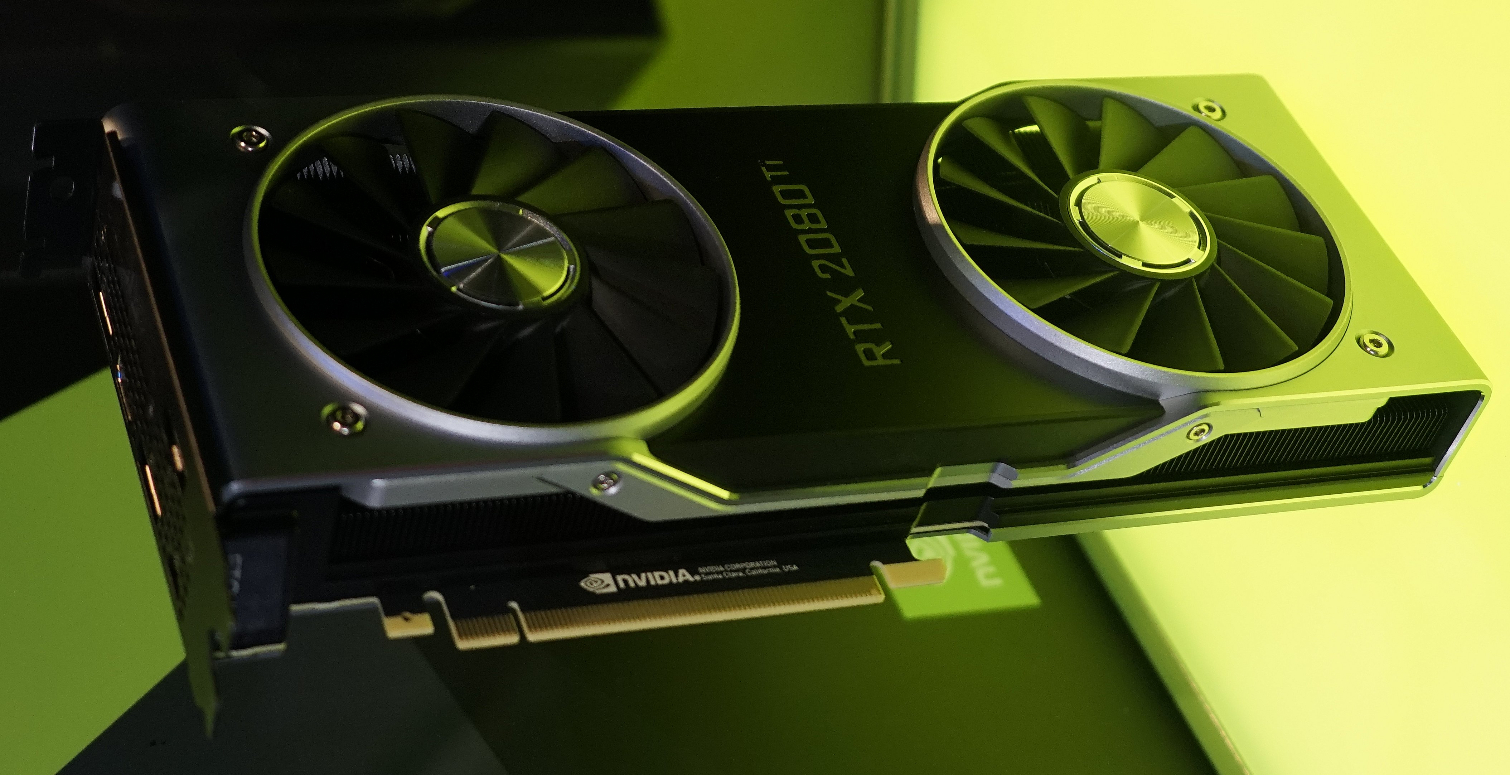Why Are Nvidia's GeForce RTX GPUs So Expensive?
Nvidia’s new Turing-based GeForce RTX GPUs are pricey, and enthusiast gamers have taken notice. The GeForce RTX 2080 Ti, the flagship card in the new gaming family of graphics cards, costs a wallet-pounding $1,199 for the first-party Founders Edition. Nvidia CEO Jensen Huang said at the company's press event that third-party cards would start at a hefty $999, but we haven't seen one for less than around $1,149.
That’s a huge jump from the last gen flagship, the GTX 1080 Ti. And there are sizable increases across every generation:
| Row 0 - Cell 0 | RTX 2080 Ti | GTX 1080 Ti | RTX 2080 | GTX 1080 | RTX 2070 | GTX 1070 |
| Starting price at launch - MSRP | $999 | $699 | $699 | $549 | $499 | $379 |
| Starting price at launch - Nvidia Founders Edition | $1,199 | $699 | $799 | $699 | $599 | $449 |
Unsurprisingly, consumers have some passionate responses to these prices. Readers in the Tom’s Hardware forums are calling for more competition from AMD, wondering if the performance benefit is worth it and saying they just won’t buy right now. On the Nvidia subreddit, there were similar thoughts on competitive pricing and keeping existing cards.
So, why are Nvidia's new Turing cards so expensive? Nvidia didn’t respond to questions about why the cards are priced as they are, but we’ll update the story if we hear back.
Analyst Jon Peddie suggests that the cost may just be a result of what it takes to make this kind of hardware.
“Simple cost-of-goods… “ he told Tom’s Hardware over email. “These giant (and they are really big) chips cost a lot to make and test, and the huge amount of memory is expensive plus the cooling systems - just [cost of goods]. There's no rip off here, no conspiracy.”
But it could also be for a variety of other reasons. Stephen Baker, vice president of industry analysis at NPD, suggested it could be due to inventory or availability.
“I think they are likely trying to price these as very premium products,” Baker said. “Certainly if there is a significant amount of series 10 cards floating around they would want to at least draw that down somewhat.”
Baker also suggested that they can use the high pricing for a gradual release as the company better understands demand: “The market for cards has been so crazy the last couple of years, between the explosion in interest in gaming, the cryptomining bubble and the upgrade in quality and demand that they would be doing themselves a disservice to come out at lower prices,” he said. Lastly, he theorizes that high prices could be a way to protect against limited inventories after the launch.
Get Tom's Hardware's best news and in-depth reviews, straight to your inbox.
One thing we don’t yet know: how the RTX GPUs perform compared to the existing 10-series. Nvidia CEO Jensen Huang spent a lot of time describing how RTX's ray-tracing feature will work, but we know very little about traditional benchmarks, and how the new series compares to the Pascal-based GPUs.
It’s possible that the new cards will be so groundbreaking that they’re worth the price, but without having our hands on the cards to benchmark them ourselves, we can’t say for sure. It’s also possible that the 10-series will offer a better value for those who don’t care about ray tracing and RTX capabilities.
Some reports over the last few months have suggested that Nvidia may have an inventory issue on its hands, including rumors that a major OEM partner returned 300,000 GPUs to Nvidia. Others suggest that this is a result of not managing the demands for gaming and mining appropriately.
During a recent conference call, Huang said that “[w]e’re expecting the channel inventory to work itself out. We are masters at managing our channel, and we understand the channel very well.” He also suggested that the inventory is in “the lower end of our stock,” so that may clear out before Nvidia announces mid and lower-tier Turing-based GPUs.

Andrew E. Freedman is a senior editor at Tom's Hardware focusing on laptops, desktops and gaming. He also keeps up with the latest news. A lover of all things gaming and tech, his previous work has shown up in Tom's Guide, Laptop Mag, Kotaku, PCMag and Complex, among others. Follow him on Threads @FreedmanAE and BlueSky @andrewfreedman.net. You can send him tips on Signal: andrewfreedman.01
-
WildCard999 Just gotta wait for those gaming benchmarks to see if the performance increase justifies the cost.Reply -
Peter Martin It’s probably because they just can’t compete they basically lost all the consoles. all they have is aftermarket video and big in the auto industryReply
Look at Xbox One X graphics and solid 60 fps gameplay fir the powerhouse that is AMD
I’ve had far less problems with AMD products in my experience
In my opinion you are paying for the name and that’s it they are no better than their counterparts -
Berain So far all I have seen from this new line of cards and ray tracing is that I shouldn't bother with replacing my 1080ti because ray tracing is only currently supported on a handful of games and isn't worth the fps hit in its infant stage at that, even less so since it would be a waste of my 4k monitor since I likely won't currently be able to max out graphics on most games using ray tracing in 4k. I will definitely be waiting on this one.Reply -
bruceghayes $150 is the top price I will pay for a card, I own a GTX 750 Ti, that games and works with 4K. I went to Utube to look at gaming card ideas and saw that one and bought it and I am very satisfied. With ID software back in gaming (Quake, Doom, and Wolfstein), $150 cards have all the power I need to play them.Reply -
Gillerer Nvidia not giving any indication about performance for current titles (compared to Pascal) leads me to believe that they're at most only marginally better, and worse in terms of performance/price.Reply
Another thought about Nvidia withholding performance numbers: Maybe with the new ray-tracing technology, they have something other than performance to tout in marketing materials without drawing too much attention to the lack of numbers? They can use this as a test case on whether people will pre-order completely blind - even at inflated prices - and if successful, will repeat this same thing for every future generation. -
Roland Of Gilead Pretty simple really. Nvidia are money gouging eejits! It also doesn't help there is no competition!Reply -
kingsol767 Many suspected the pricing would be high. At least until the 10 series inventory is consumed. Over compensation for mining. They are basically avoiding stepping on the price points of the remaining 10 series cards. There is no need for benchmarks. The cards are going to be a marginal step up from the 10 series. The big leap will not happen until ray tracing is main stream. The first driver update will probably unlock the cards full potential.Reply -
bogdan_ea Blame AMD not Nvidia. When competition is lackluster and you are so good (Nvidia used 16nm tech miles better than AMD) you are entitled to demand some extra cash.Reply
The one thing I don't understand is how so many games can afford such expensive video cards. -
why_wolf While I'm sure cost of parts increased some it definitely didn't increase enough to equal the price increase we are seeing. So most of the increase is just due to Nvidia's only competitor at the high end is last gen Nvidia cards. That and as they figured out with the founders cards there is a certain % of people will pay extra just to be first.Reply
When AMD belatedly rolls out something that can compete Nvidia will just drop the price. So at least they drop their prices, unlike Intel which just stubbornly maintains pricing no matter what. -
WildCard999 Reply21252455 said:Nvidia not giving any indication about performance for current titles (compared to Pascal) leads me to believe that they're at most only marginally better, and worse in terms of performance/price.
Another thought about Nvidia withholding performance numbers: Maybe with the new ray-tracing technology, they have something other than performance to tout in marketing materials without drawing too much attention to the lack of numbers? They can use this as a test case on whether people will pre-order completely blind - even at inflated prices - and if successful, will repeat this same thing for every future generation.
21252509 said:Blame AMD not Nvidia. When competition is lackluster and you are so good (Nvidia used 16nm tech miles better than AMD) you are entitled to demand some extra cash.
The one thing I don't understand is how so many games can afford such expensive video cards.
Multiple jobs, selling a kidney, etc.
